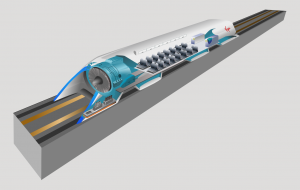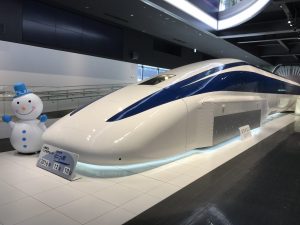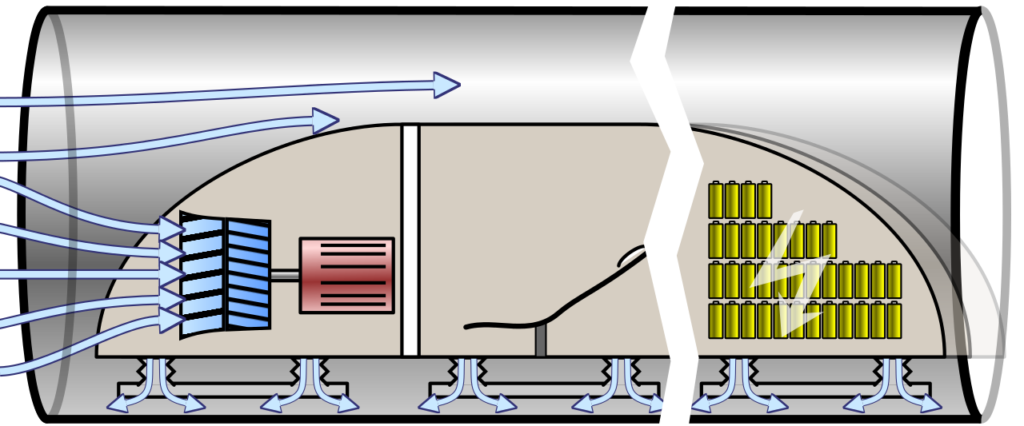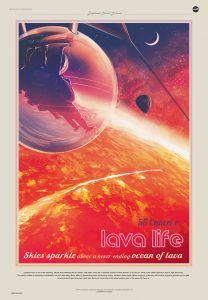Soon this mind-blowing high-speed vactrain may be a reality, and not only on planet Earth.

Image source: https://search.creativecommons.org/photos/fcc00d1c-259d-4daa-b372-380c3eb50dfd by sam_churchill
A New Transport System
A Hyperloop is a new mode of transport, used to describe an open-source vactrain (a high-speed train using tube or tunnels to reduce air resistance) proposed by Tesla and SpaceX. This system of tubes should allow travel to be air resistance-free, collisions-free, faster than a train or airplane and energy-efficient. It was called “hyperloop” because it would go in a loop. This system would reduce travel times and power consumption. Firstly mentioned in 2012 by Elon Musk, the initial concept included tubes in which pressurized capsules ride on air bearings, driven by axial compressors and linear induction motors.

Image source: https://en.wikipedia.org/wiki/Hyperloop#/media/File:Hyperloop_all_cutaway.png
A Century Old Dream
The Hyperloop was inspired by the idea of trains traveling through century-old evacuated tubes. Elon Musk mentioned this “fifth mode of transport” at a PandoDaily event in California. Later this system was jokingly described as a “cross between a Concorde (a jet) and a railgun and an air hockey table”. The official Hyperloop Alpha concept was published in 2013, proposing a route from Los Angeles to San Francisco Bay Area. The hyperloop would be able to travel at a speed of 760 mph (1,200 km/h), covering that distance in about 35 minutes.

Image source: https://search.creativecommons.org/photos/af19b055-300d-446a-87ed-4d6c233862a6 by tataquax
Concept Design
The major difficulties in developing high-speed trains are friction and air resistance, both of which increase when an object approaches high speeds. Theoretically, vactrain eliminates these problems by employing magnetically levitating trains in evacuated or partly evacuated tubes. Nevertheless, vactrain has never been realized due to the high cost of the system and maintenance. The Hyperloop concept is based on aptly designed “capsules” or “pods” travelling through a steel tube maintained at a partial vacuum. This mechanism is similar to how pucks are levitated above an air hockey table (as stated by Musk) and allows faster speeds than wheel-trains. The capsule would accelerate or decelerate thanks to linear induction motors located along the tube. Rolling resistance hence eliminated and air resistance reduced, so the capsules can glide consuming little energy.

Image source: https://en.wikipedia.org/wiki/Hyperloop#/media/File:Hyperloop_capsule.svg
Not Only On Earth
Another futuristic usage suggested by Musk would be the adoption of this travel system on Mars. The red planet’s atmosphere is about 1% the density of the Earth’s at sea level, therefore Mars has a significantly lower air resistance. This means that on a hypothetical hyperloop on this planet requires no tubes, but only a track for the vehicle.

Image source: https://search.creativecommons.org/photos/8c391031-19e7-45fa-bf33-729819ea36d7 by NASA Goddard Photo and Video
Info source:
https://en.wikipedia.org/wiki/Maglev#History
https://en.wikipedia.org/wiki/Hyperloop#Theory_and_operation
https://www.physicsclassroom.com/class/newtlaws/Lesson-3/Free-Fall-and-Air-Resistance
https://en.wikipedia.org/wiki/Vactrain#18th_century
